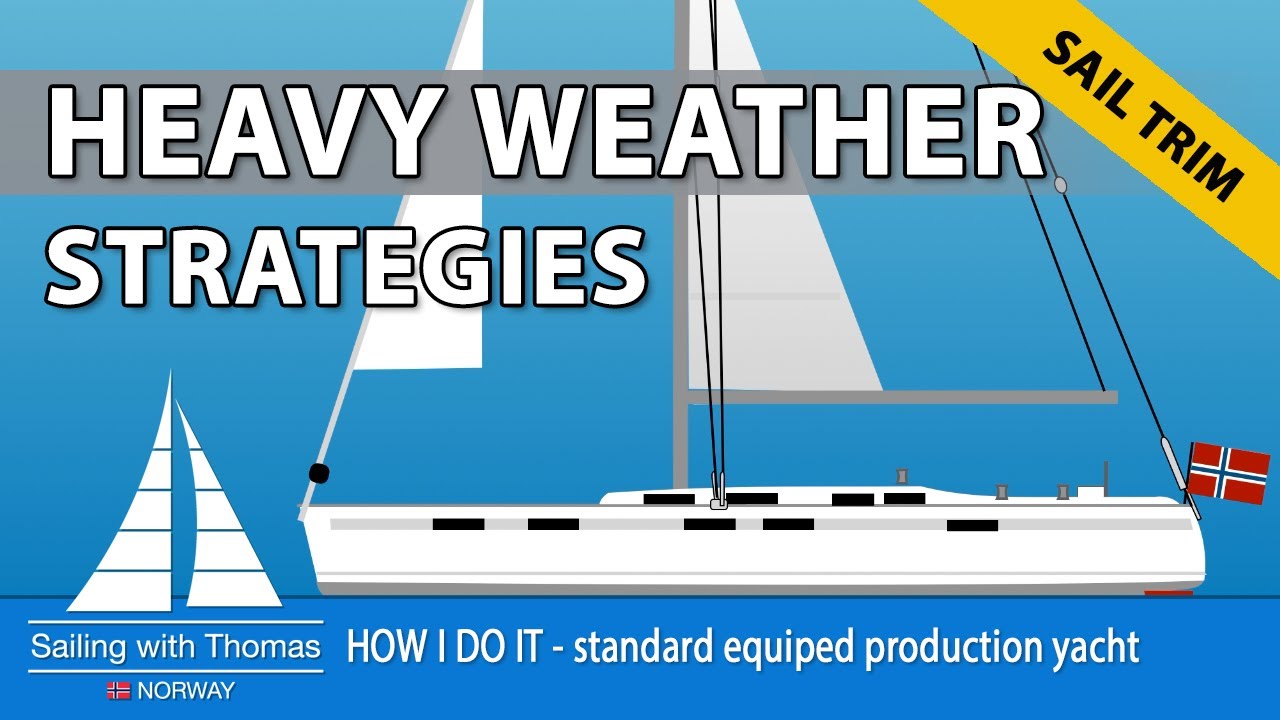În acest episod, vă împărtășesc experiența și cunoștințele mele despre manipularea în siguranță a iahtului meu Bavaria 55 de producție în masă printr-o furtună violentă. Este o mare diferență între a alerga și a fi pe o distanță lungă în locuri îndepărtate. Unii ar putea sări la concluzii care sunt greșite. Acesta este un mod defensiv de a naviga cu vânturi de peste 55 de kt și de pregătire pentru peste 60 de kt. Am o responsabilitate uriașă, deoarece oamenii care urmăresc îmi pot copia și adesea îmi vor copia strategia. De aici, faptul că acest lucru nu este laudă sau exces de vânzare. Este realist și ține cont de siguranță m. Acesta este un videoclip mai tehnic în care îmi dezvălui strategiile în navigația pe vreme grea din viața reală. Vorbim de peste 55 de noduri de vânt unde lucrurile încep să se întâmple cu adevărat. Strategiile mele cu o velă de furtună și un Main cu recif s-au dovedit a funcționa peste 60 de noduri de vânt. Ultimul episod nu am fost echipat cu vele de furtună, deoarece nu a fost prezis. Așa că vă arăt limitările și ce am făcut când am văzut 57. Neștiind cât va fi, am luat o pauză pentru a decide următoarea mișcare. Dacă urma să ajungă la 60, ar trebui fie să continui cu modul meu de siguranță, fie să merg doar cu reciful 3, adică să merg împotriva vântului pentru a ridica Main cu reciful meu violent de furtună. Fără să vă spun cum, vă împărtășesc cum fac. Acest lucru s-ar putea să nu funcționeze pentru tine sau chiar cu barca ta. Și acesta este punctul meu de vedere. Vă recomand să vă cunoașteți nu numai propriile limitări, ci chiar și limitele bărcii dvs. Îți împărtășesc chiar de ce o strategie ar putea fi calea rapidă pentru a-ți trimite platforma în ocean. Același lucru este valabil și pentru o genoa cu înfășurare. Acest lucru are anumite limitări și poate fi periculos. O mulțime de incidente de demontare apar din anumite motive evidente, dar despre care se vorbește cumva rar. Eroarea umană care duce la probleme grave este adesea confundată cu o calitate slabă și este foarte popular să arate spre iahturi de producție în loc să se uite în oglindă. O mulțime de mituri informații false și chiar sfaturi periculoase. Nu toate strategiile funcționează pe toate bărcile. Diferitele dimensiuni și modele de carenă dau adesea rezultate diferite. Dacă nu aș cunoaște limitele bărcii mele, dacă nu aș fi fost în frunte cu întreținerea și chiar dacă aveam experiență, rigg-ul meu s-ar prăbuși. Aceasta este cheia pentru înțelegerea navigației în siguranță și a supraviețuirii unei furtuni violente. Sperăm că unii vor găsi acest lucru valoros și chiar îi vor îndruma pe unii dintre voi într-o nouă direcție, afland mai multe despre cum să faceți singuri situațiile. În mod normal, nu pretind că am planul și nici nu spun că așa se face. Împărtășesc ceea ce s-a dovedit că funcționează pentru mine. Subliniez chiar și cea mai mare și mai frecventă neînțelegere. O ședere de tăiere este bună, dar nu este cea mai bună soluție pentru navigația pe vreme grea. Cu excepția cazului în care aveți doar un mic braț de furtună acolo pentru navigație de peste 50 kt. Încă nu am întâlnit pe nimeni cu asta permanent, în schimb, au genoa ceva mai mică, folosită în mare parte pentru a zbura aripă pe aripă. Înseamnă că am avea exact aceeași provocare. Schimbarea velelor este cea mai mare provocare a mea singur pe mare, iar asta înseamnă că soluția mea de furtună violentă are călcâiul lui Ahile. Nu pot face față unei furtuni violente așa cum vreau, dacă nu sunt planificată. Deci, ceea ce împărtășesc este consecința unei previziuni meteorologice care se dovedesc a fi serios în afara țintei. Modelele europene de predicții sunt în mod normal extrem de bune. Cu toate acestea, fenomenul local poate fi omis uneori. Un braț de furtună într-o geantă atașată funcționează bine, dar experiența mea este că nu poate fi înfășurat. Deci, ca marinar solo cu un braț de furtună, nu este posibil să-l înfășurați, creați o altă provocare. Ce trebuie să faceți când ajungeți la 75. Vă mulțumim foarte mult pentru etichetare și pentru clienții care ne ajută să facă acest videoclip posibil. Patreon: https://www.patreon.com/Sailingwiththomas VA MULȚUMESC PENTRU VIZIONARE ȘI ABONER! De asemenea, puteți urmări navigarea cu Thomas pe alte platforme pentru fotografii și videoclipuri actualizate aproape zilnic și chiar să vă găsiți un tricou nou: Facebook: https://www.facebook.com/sailingwiththomas Instagram: https://www.instagram .com/sailingwiththomas Magazin: https://sailingwiththomascom.wpcomstaging.com/shop/ DESPRE ACEST CANAL: Navigați în jurul lumii cu un Bavaria 55 Cruiser, realizând videoclipuri ori de câte ori avem timp pentru asta. Chiar dacă acesta este sezonul 6 pe YouTube, nu am făcut atât de multe videoclipuri la început. Înainte de a naviga cu normă întreagă, am navigat mai multe sezoane în Marea Mediterană și, evident, și în Scandinavia. Am mai călătorit în lume și am fost, de asemenea, un navigator activ de regate. Am avut prima mea barca cu pânze la vârsta de 7 ani și de atunci navighez. De asemenea, peste 10 ani de experiență în căutare și salvare pe mare în Norvegia. VA RUGAM SA FITI AMABILI IN COMENTARII! Sunt doar o persoană normală care împărtășește aventura mea de călătorie prin ochii mei și experiența din perspectiva mea! Amintește-ți cum fac lucruri care ar putea funcționa pentru mine, dar nu și pentru tine. S-ar putea chiar să nu fie modul corect de a face lucrurile și nici eu nu am planul. Nu sunt perfect și nimeni nu este. În ziua în care cred că știu totul și nu cred că pot învăța lucruri noi, ar trebui să plec la țărm.
source
VÂLIZAREA PENTRU VREME GRELE CU UN YACHT DE PRODUCȚIE STANDARD – SwT 162 – CUM O FAC ȘI STRATEGILE MELE





Great video Thomas. Thank you for your honesty. Have read a few books about heavy weather sailing and also watched many videos. Never found my selv in heavy weather sailing conditions yet. With your video you have managed to touch many good points in a very good way. Well done!
Thank you Thomas for your explanation very useful.
Thanks Thomas for some good advice in this video. I like your style of storytelling.
I have a baby stay but it is not made for a sail, to keep mast from pumping, was thinking of trying the storm sail on it anyway. for a test.
👍👏👍
Heisann Thomas, very good points you have made… I have a storm sail small triangle that goes on my so-called 'Baby stay' just forward of my mast… This is by guesswork but with your very good demo I now understand very well the purpose of my boat rigging design… Tusen takk and Fair Winds…
this video will open the eyes of some lesser experienced sailors crusing the worlds oceans , valuable insights ,thanks . this type of sailing sure keeps you in the moment my friend .
Great lesson. Thank you.
No BS just cruising!
cheers mate
Excellent Thomas!
Of course I think it is excellent because I agree with everything you talked about.
Some people like drama so they magnify everything they talk about, others are dramatic because they truly are afraid. Terrified even. I don't like roller furling for the reason you mentioned it is very handy but dangerous if you are in serious weather. Most modern boats have the boom really high above the deck to clear dodgers and biminis but that makes reefing much more dangerous.
If I had a boat like yours, I would have a permanent storm-stay set up from just in front of the coachroof bump on deck (to the nearest bulkhead) to the lower spreaders with a halyard for a hank on storm jib of heavy cloth, stowed with its own sheets attached in a storm bag. I prefer a cutter or a double headsail ketch because of the flexibility the two forestays offer for various sails. Nope, not as efficient upwind as a sloop, but safer and easier for one or two people to handle in storm conditions. I doubt many cruisers carry a storm trisail anymore that ran on the mainsail track but replaces the mainsail in storm conditions. It would be a pain to remove the mainsail slides from the track to run a trisail up it. But they were good for getting the center of effort of the sail down much lower.
I've only had to use my storm jib and triple reefed main a few times when the wind got over 40 kts and the storm jib alone at higher wind speed. Once we were bare poles for a few hours and still doing 10+ kts downwind. And many times I've sailed in from a rough passage in company with another boat and they always estimated the wind speed and wave height much higher than it was. Part of that was because they had no instruments but part was it was the worst conditions they had ever been in and were scared. As you said, once you've been in worse it isn't so bad… Until we get into the worst we have ever been in and it becomes our new benchmark.
When you are mid-ocean and at the crest of a wave with a valley ahead and behind you where the bottom of the trough looks 100 feet below, then you sail down the face or back of the wave and at the bottom of the trough you are looking up and up at the crest of the wave in front and behind you that look like 12 story buildings, with very little wind down there but howling wind when you are on the crests, now that tends to be a bit scary until you do it for several hours and start to relax and enjoy sailing in the "Grand Canyon" ocean and you know that you will never be able to describe the feeling you have. Then the sun goes down and the heavy, dark clouds cover the sky and the rain starts falling… or going sideways actually, then the sounds of the wind and breaking crests of the waves that were so exciting during the daytime become much scarier in the pitch black.
Good times!
On a good boat that is well prepared for really heavy weather that is actually rarely encountered.
Thanks
Know your boat, don’t stress the rig. Which goes back to know your boat. The graphics are great! Thank you for your time and effort
Hi Thomas, thank you for your insight on all the sailing. It’s wonderful that you want to share your knowledge with others. Keep up the good work. Hope your other half will come back soon. Cliff from Logan city Queensland, Australia 🇦🇺🧑🏾🦽
Thank you for very usefull information. Your knowledge is well respected.
wow, extremely well said and thought out. Thank you Thomas. If you have the chance to watch the latest episode of "adventures of an old seadog" on youtube, he proves everything you just covered. He made every unforced error and abandoned his boat. He was lucky to survive and lucky to be rescued. He knew the storm was coming, he didn't accomodate his sail set-up accordingly, he didn't run his engines in the calm before the storm and when he needed it, it didn't work. All in all, he is alive and lucky and he should watch this videoe 10 times over. God speed, sail well. cheers
Very interesting and informative. I know staysail on my 50 is a must. I did not know forestay roller furler reduced sail in extreme winds could possibly bring the mast down through flogging. Normally I have the stay sail up in strong winds. Thanks
The great thing about you Thomas is that you give back a lot to other sailors . Well done
Storm-bag ( patented ) could be an option; stormjib in a bag that you mount on the furled jib ( watch the videos on YT ), would also prevent the shaking of the furled jib, altough you should tighten the jibsheets to prevent the headstay shaking. A cutter stay is a security to unknown conditions you will meet at sea.
The blue dismasted boat is a Koopmans dutch design strong blue water cruiser and indeed, i am impressed at the capacities of Bavaria's, being a low cost! production boat. Though Jambo ( german YT ) on a Bavaria 34? lost his mast in not so heavy weather and finally ( in an other mishap ) sunk few weeks ago in the Atlantic. Stay safe.Greets from Belgium.
With the Caveat that pretty much any Rig can be made to Work. My favourite Rig is KISS based principles built around an in Mast Furling MInsail, and a basic Sloop Rig with a single forestry with a bowsprit for Furling light wind Sails, and a Furling TriradialGenoa with three reefing points. The Main has a 3+Reefing point Triradial Battenless Construction, and the third reef (this to test the theory) having two reinforced reefing points in it, to keep the lastDouble Storm reefed Cloth very reduced area and right next to the Mast, with no Cloth at the Bow so now leverage to break heaving to. So pretty much in line with your thinking Thomas, but from a bit different direction to achieve the same effect. For Durable Sails that will keep their shape and at fairly affordable prices, Triradial build imho, is the best way to go, from about double the price of baggy pants in no time Crosscut Dacron, but they can last over ten times as long with Sail Valeting and servicing at regular intervals. Non Mylar Laminates are looking promising, but they are outside of my price range tbh. Needless to say, This extremes of Boat Sailcloth leverage, for me, rules out a Ketch Rig. But it does bear repeating, that A Ketch Rig can be made to work as well, but for someone disabled like myself, it is far too dodgy to consider, and the same goes for twin Forestay Rigs. Everything must go back to powerful electric winches and Clutches in the Cockpit. In storm Force Winds, you don’t want to have underpowered Winches, or an Undersized inboard engine for that matter, you need power to spare to be able to tick along to get out of the Storm area, or make it into clear Water Offshore and away from Land. While difficult in a Storm, it is important to keep stresses on the Rig, Sails, and boat, as low as possible. Admittedly, my considerations are particularly tailored to my needs, but hopefully there is useful food for thought in this post for others. Best Wishes, Fair Winds, and Safe Travels. Bob in Wales. 👍🏴🇬🇧⛵️🌟🌟🌟❤️
PS. I must echo the importance that you stress of good Maintenance, which to me has always made an annual Haulout for a thorough checkover and Service, plus seeing if any early Replacements are wise to carry out. Bob. 🤔👍
I can only imagine. Truly thankyou for being real Thomas
I like your approach to giving information as it allows us to think and manage our own risks and fills our desire to learn more.
In knowing your boat and own limitations…I would like to think that as a human you don’t have limitations…perhaps just more to learn and challenges to overcome.
May we forever be humble students in life as you are helping us be.
Thanks again Thomas.
Thank you for your explanation, it makes sense any sailing boat you have you must maintain especially when doing extensive sailing and you must know your limitations on your set up
Everything you mentioned I take and learn from it
Again thank you 🙏
Thank you Thomas, excellent video and awesome to hear your insights! Well done!
Lack of drama is so refreshing thank you.
Very informative Thomas! Have you explored the ATM Storm jib? It is made to go over your rolled up head sail. As to reefs in the main, I installed a 4th reef on my previous boat that could be taken from the cockpit that acted as the storm trysail. (See Skip Novak's videos on Heavy Weather Sailing).
👍Thom
THANK YOU! That explains everything I was questioning.
If you can hoist a stormsail on a baby stay, you probably can then forereach into the weather which would be good. Just depends on where you can apply the load on the mast without risk of inverting it. That could also dismast you if the winds are strong enough. A good rigger could & should advise you on the details.
it's always a pleasure to listen to your explanations about sail experience and your advises how to handle different situations.
Thank you for that video. Very thought provoking concerning the rig etc. The best to you!
Do you just steer into the wind to reef the main? Or would you heave-to to reef up to a certain windspeed that does not put your rig at risk?
Valuable info as always. Never sailed in my life, but still it feels like I am learning by watching your vidoes and your experiance .
Just wandering about the dismasting events & the statements regarding high winds tearing the rig down.
In theory, with a monohull, max loading is when the wind is from port or starboard & with full sails up, the boat should simply heel over thereby inherently limiting the loading to below the rig damage level. That's how rigs in the 80s were designed, it's one of the distinct advantages of monohulls.
It seems from recent events that the rig loading capabilities of some production sailboats have been reduced below that which was acceptable in the 80s. Seems odd that one of the distinct safety advantages of monohull sailboats would be thrown out the porthole for a halfpenny's worth of tar.
It seems what's being done with rig load ratings these days wouldn't have been tolerated in the 80s.
So rig design strength should be so that all of the rig can withstand a full wind force 90° knockdown with a load safety margin.
With this adequate strength rig then Sail area is reduced to suit wind loading & thus limit wind force loads & to give a reasonable heel angle.
In very heavy winds sailing angle to the wind course adjustments & storm sails can be used to reduce loading while still providing reasonable heel angle & provide some sail force stability, automatic unloading occurs as before with automagical heel angle changes.
A short heavy duty storm sail stay & short heavy duty extra storm sail track attached to the mast are invaluable.
Thomas I always learn from watching you👍I never thought about the jib being up above the water too high.As if a rolled furler Genoa.Also what combination of jib and mainsail is preferable in high winds.You explained it very good and I understood why you do what you do in high winds.Made perfect sense to me.Always enjoy every episode you put out and 2 or 3 this week is great!!Thank you 🙏🙏
Bravo Thomas, and thanks for sharing your experience , which counts soo much. Forewarned is well prepared 😊
EXCELLENT, Thomas!!! This was both interesting and educational, and I am so appreciative of you taking time to create and share these important points of view with your experiences and how they relate, specifically, to Be Free! Thank you so much!!! ~ Chelle ⛵
P.S. Just bought a One Life Sail it Wisely/Sailing with Thomas t-shirt – so cute and can't wait to get it! 💕⛵
Really Like the New Thumbnails for this sort of Information. makes finding them on your site ez, when i want to review. Thank You Professor 😎
Two comments:
1. a true pro makes difficult actions look easy.
2. making a big production or even panicking does not help. The weather will not be impressed by your antics.
Good episode. Thanks for that.
Great channel Thomas. Just to clarify, once you were in ‘safety mode’ you just headed downwind to ride out the conditions correct?
PS you remind me of the Norwegians I met at school. No BS!
Thank you for the education. I am a novice sailor and after watching your dream heavy weather sail setup for your boat, I am wondering if you would think a sloop design would be better in heavy weather?